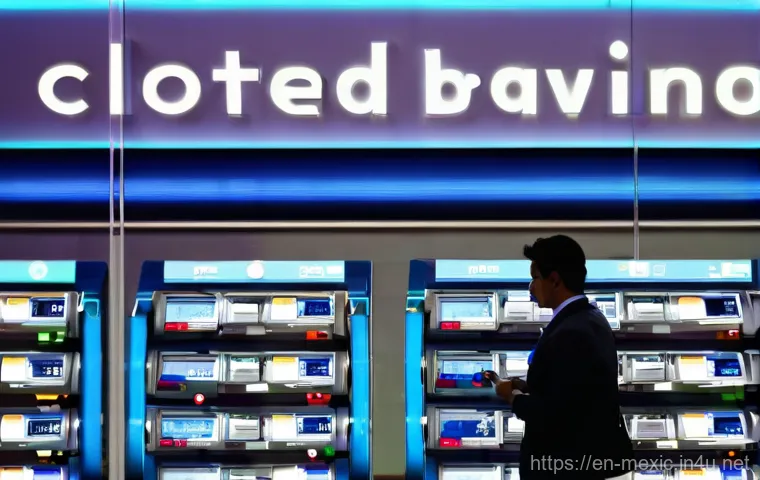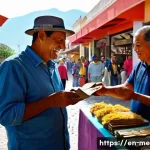If you’ve been dreaming of living the vibrant Mexican life, soaking up the sun, and enjoying that incredible culture, then you’ve probably also wondered, “How on Earth do I handle my money there?” Believe me, I’ve been there!
The idea of navigating a new country’s banking system can feel a bit daunting, almost like trying to understand a super spicy salsa recipe without a guide.
But let me tell you, Mexico’s financial world is far from what you might imagine. It’s buzzing with innovation and surprisingly user-friendly options, especially now.
I remember when I first moved here, I thought I’d be stuck with cash forever, but things have dramatically changed. We’re seeing a massive wave of digital transformation, with super cool fintech companies popping up everywhere, making everything from daily payments to international transfers incredibly smooth.
Major players like BBVA and Banorte, alongside dynamic digital banks like Hey Banco and Nu, are truly revolutionizing how we manage our pesos. They’re embracing mobile banking like never before, offering sleek apps and online services that rival anything back home.
Plus, with Mexico’s stable economy and competitive interest rates, it’s actually becoming a really smart place to keep your money and even grow it. Forget the old stereotypes; the future of banking in Mexico is here, and it’s exciting!
Let’s dive deeper and get you all the juicy details.
Embracing the Digital Wave: Your New Banking Reality

If you’re anything like me, you’re probably used to doing everything from your phone. And good news, Mexico is totally on board with that! The country’s financial technology scene, or “fintech” as we savvy folks call it, is absolutely exploding. This isn’t just about big, traditional banks slowly catching up; it’s about a whole new breed of financial services that are shaking things up and putting convenience right in your pocket. I remember being so worried about international transfers and paying bills when I first moved, but now, it’s honestly a breeze. These new platforms have made financial tasks incredibly accessible, often cutting out the need for tedious branch visits. It’s truly a game-changer for anyone moving here, especially if you’re coming from a country where digital banking is the norm. The speed and efficiency are something to behold; it’s almost like they custom-built these services with people like us in mind. Plus, the competition means better services and more innovative features for everyone.
The Fintech Frenzy: Who’s Leading the Charge?
- Honestly, the sheer number of cool fintech companies popping up here is mind-blowing. We’re talking about companies that are rethinking everything from how you send money to how you save it. Digital banks like Hey Banco (from Banregio) and Nu are truly making waves, offering accounts that you can open almost entirely online with minimal fuss. I’ve personally tried a few, and the user experience is often slicker than some of the apps I used back home. They’re all about making banking less of a chore and more of a seamless part of your day. This competition is fantastic for consumers, driving innovation and pushing traditional banks to step up their game. It’s a dynamic environment, and it means more choices and better services for you, the customer.
- Then there are payment apps and digital wallets that are becoming incredibly popular. Think about being able to pay for your tacos, your groceries, or even your internet bill with just a tap on your phone. Many small businesses are now accepting digital payments, which is a huge convenience, especially when you might not want to carry a wad of pesos around. I’ve found these super handy for everyday expenses, and they truly simplify my life here. It’s incredible how quickly Mexico has adapted to these digital solutions, making daily transactions smoother and more secure.
Why Mobile Banking is Your New Best Friend
- Forget long lines and stacks of paperwork – mobile banking in Mexico is incredibly robust and user-friendly now. Most major banks, even the traditional giants like BBVA and Banorte, have invested heavily in their mobile apps. And let me tell you, they are good. You can do almost anything on your phone: check your balance, transfer funds between accounts, pay bills, even apply for loans or credit cards. My own experience has been overwhelmingly positive; I barely ever need to step foot inside a physical bank. It’s all about convenience, and these apps deliver in spades. It’s saved me so much time and hassle, allowing me to focus on enjoying life here rather than worrying about banking logistics.
- The security features on these apps have also come a long way. Two-factor authentication, biometric logins, and real-time notifications for transactions are pretty standard now, giving you peace of mind. I really appreciate getting instant alerts for every transaction, it helps me keep track of my spending and immediately flags anything suspicious. It makes managing your money feel much more secure and gives you a greater sense of control. This digital empowerment is something I truly value living abroad.
Your Essential Guide to Choosing the Right Bank
Deciding which bank to go with can feel a bit like choosing a favorite taco stand – so many delicious options, but which one is truly for you? It’s not just about who has the prettiest app; it’s about finding a financial partner that genuinely understands your needs as someone new to Mexico. I’ve spent countless hours researching and personally testing different banks here, and I can tell you that what works for one person might not be the best fit for another. My advice? Don’t just jump into the first option you see. Take some time to compare their offerings, especially focusing on things that matter to expats: international transfers, ATM access, and how easy it is to communicate with them if you only speak English. It’s also crucial to consider their branch presence if you prefer in-person services, although I’ve found myself relying less and less on physical branches as digital banking improves. The key is to look beyond the surface and find a bank that aligns with your lifestyle and financial habits. I’ve learned this the hard way, and trust me, a little research upfront can save you a lot of headaches later.
Traditional vs. Digital: Which One Suits You?
- This is often the first big decision. On one hand, you have the established players like BBVA, Citibanamex, and Banorte. These are the giants, with extensive branch networks and ATMs everywhere. They offer a full range of services, and sometimes, if you need to handle complex transactions or prefer face-to-face interactions, a traditional bank can feel more reassuring. I’ve had accounts with both traditional and digital banks, and for certain situations, like when I first needed to set up specific direct debits for utilities, the more established presence of a traditional bank felt comforting. They also tend to have more physical infrastructure if you ever need to resolve something in person, which can be a relief for some.
- Then there are the digital-first banks like Hey Banco, Nu, and Klar. These are often quicker to open accounts with, have super user-friendly apps, and often boast lower fees (sometimes even none!). If you’re comfortable managing everything digitally and rarely need a physical branch, these can be fantastic. I personally love the simplicity and the modern feel of these digital banks. They often come with innovative features and a customer service approach that feels more aligned with a tech company than a bank. For day-to-day spending and quick transfers, I often lean towards my digital bank accounts.
Key Features to Look For in a Mexican Bank Account
- When you’re comparing options, keep a few things in mind. First, look at the fees. Are there monthly maintenance fees? What about ATM withdrawal fees, especially from other banks’ ATMs? International transfer fees can also add up, so check those carefully. Second, consider their mobile app and online banking platform – is it intuitive? Does it offer English language support? Third, think about customer service. How easy is it to get help if you have a problem? Is there an English-speaking support line? Fourth, ATM access is a big one. Even if you’re mostly digital, having easy access to cash when you need it is crucial. Finally, look for any perks like cashback programs or favorable exchange rates, as these can make a real difference over time. I always cross-reference these points, because what seems like a small detail can become a major inconvenience if you don’t consider it early on.
- For me, the ability to seamlessly integrate with local payment systems like CoDi (Cobro Digital) has become a non-negotiable. CoDi allows for instant, QR-code based payments directly from your bank account, and it’s increasingly adopted by merchants. Having a bank that fully supports this makes life incredibly easy. Also, checking if they offer a debit card that works internationally is super helpful for when you travel back home or to other countries.
Unlocking the Power of Digital Banking Apps
Once you’ve got your bank account sorted, the real magic happens when you dive into their digital offerings. Seriously, these apps are like having a personal financial assistant right in your pocket. Gone are the days of needing to visit a physical branch for every little thing. I remember when I first moved here, I was still mentally preparing myself for dealing with bureaucracy, but then I downloaded my bank’s app, and it was a revelation! From checking your balance in real-time to paying your bills with just a few taps, it’s all incredibly intuitive. Most major banks, both traditional and digital-first, have invested heavily in creating sleek, user-friendly interfaces that rival anything you’d find in the US or Canada. It truly empowers you to take control of your money, no matter where you are. I can’t stress enough how much easier my life became once I fully embraced mobile banking here. It’s not just a convenience; it’s a necessity for modern living in Mexico.
Seamless Bill Payments and Transfers
- Paying bills in Mexico used to be a bit of a trek, involving various payment centers or standing in lines. But now? It’s a dream! Almost every banking app allows you to set up automatic payments for your electricity (CFE), internet, water, and even phone bills. You can also easily transfer money to friends, family, or local businesses using their interbank transfer system (SPEI). It’s usually instant, even between different banks, which is a huge bonus. I regularly use SPEI to pay my rent, my cleaning lady, and even local vendors. It’s incredibly efficient and has virtually eliminated the need for carrying large amounts of cash for these transactions. This level of integration and ease of use is something I truly appreciate every single day.
- Setting up recurring payments for subscriptions or utilities means one less thing to worry about. I love that I can just “set it and forget it” with my monthly bills, knowing they’ll be paid on time without any effort from my end. And for those one-off payments, the QR code scanning feature in many apps makes it super quick and error-free.
Beyond the Basics: Budgeting and Savings Tools
- Many modern banking apps in Mexico are now integrating smart budgeting and savings tools. This is fantastic for expats who are trying to get a handle on their new expenses. You can often categorize your spending, set budgets, and even create savings goals within the app. Some even offer virtual cards for online shopping, which adds an extra layer of security. I’ve found these features incredibly helpful for tracking where my pesos are going and making sure I’m sticking to my budget. It’s like having a financial coach constantly available at your fingertips. This proactive approach to money management is something that wasn’t widely available here just a few years ago, and it’s a testament to how quickly the financial sector is evolving.
- I particularly enjoy the instant notifications for every transaction. It’s a small detail, but it makes a huge difference in keeping tabs on my spending and quickly spotting any unauthorized activity. Plus, many apps let you easily pause or unpause your debit card if you misplace it, which is a handy security feature I’ve thankfully never had to use, but it’s comforting to know it’s there.
Mastering Transfers and Payments Like a Local
Once you’re settled with your bank, understanding how money moves around in Mexico will make your life incredibly smooth. It’s not just about the apps; it’s about knowing the local lingo and systems. Believe me, when I first started, I was a little overwhelmed by terms like SPEI and CoDi. But once you get the hang of them, you’ll feel like a true local financial wizard! These systems are designed for speed and efficiency, making everything from splitting a restaurant bill with friends to paying your landlord incredibly simple. I’ve come to rely heavily on these methods, and they’ve definitely streamlined my financial interactions here. Forget the old notions of waiting days for transfers; in Mexico, things move fast, which is a huge plus when you’re managing daily life and expenses. It’s truly a testament to the country’s commitment to modernizing its financial infrastructure, something I’ve personally benefited from time and again.
Understanding SPEI: Your Instant Transfer Lifeline
- SPEI (Sistema de Pagos Electrónicos Interbancarios) is the backbone of interbank transfers in Mexico. It allows for instant transfers between different banks, 24/7. When someone asks for your CLABE (Clave Bancaria Estandarizada – a unique 18-digit interbank account number), they’re typically looking to send you money via SPEI. It’s incredibly reliable and widely used. I use SPEI constantly for everything from paying my rent to sending money to local businesses. It’s fast, secure, and has really simplified my financial life here. Just make sure you always double-check the CLABE before hitting send! A single wrong digit can send your money to the wrong place, and while it’s usually recoverable, it’s a headache you want to avoid.
- The beauty of SPEI is its immediacy. Unlike some international transfers that can take days, SPEI transactions often clear within seconds, making it ideal for time-sensitive payments. Most banking apps integrate SPEI seamlessly, allowing you to initiate transfers with just a few taps once you have the recipient’s CLABE and bank name.
CoDi: The Future of Frictionless Payments
- CoDi (Cobro Digital) is Mexico’s answer to QR code-based payments, and it’s gaining traction quickly. It allows you to make instant payments directly from your bank account to a merchant’s or individual’s account by scanning a QR code or accepting a push notification. It’s fantastic for small purchases at local markets, cafes, or even street food vendors who display a CoDi QR. It bypasses card fees and makes transactions super quick and secure. I’ve been using CoDi more and more, especially at places where I might not want to use my physical card. It’s incredibly convenient and feels very futuristic, truly a step into cashless living. It’s a great example of Mexico embracing cutting-edge financial technology.
- To use CoDi, you simply need a bank account that supports it (most major banks do now) and your bank’s mobile app. When you see a CoDi QR code, just open your app, scan it, confirm the amount, and you’re done. No card swiping, no cash handling, just instant payment confirmation. It’s a game-changer for everyday transactions and adds another layer of security by not exposing your card details.
Keeping Your Pesos Safe: Security Tips and Tricks
Living in a new country always comes with a learning curve, and managing your money securely is definitely a big part of that. While Mexico’s banking system is advanced, just like anywhere else in the world, you need to be smart and vigilant about protecting your finances. I’ve picked up some essential habits since moving here, and honestly, they’ve saved me a lot of potential headaches. It’s not about being paranoid; it’s about being proactive and informed. From protecting your online credentials to being aware of common scams, a little bit of knowledge goes a long way in ensuring your financial peace of mind. Remember, your money is your responsibility, and taking a few extra precautions can make all the difference. I always tell my friends that a moment of caution is worth more than hours of trying to recover lost funds. Staying informed and practicing smart habits are your best defenses against potential issues.
Safeguarding Your Online Accounts
- First things first: strong, unique passwords for all your banking apps and online portals are non-negotiable. Don’t reuse passwords, and definitely use a password manager if you’re not already. Enable two-factor authentication (2FA) wherever possible – most banks offer it now, and it’s a crucial layer of security. I also make it a point to regularly check my account statements for any unauthorized transactions. A quick glance at your activity log can catch something suspicious before it becomes a big problem. And please, be wary of phishing emails or text messages that claim to be from your bank. Banks will rarely ask for sensitive information like passwords or PINs via email or text. If in doubt, always call your bank directly using a number from their official website, not one from a suspicious message.
- Another personal tip: avoid doing online banking over public Wi-Fi networks. These can be insecure and make your data vulnerable. If you absolutely need to bank on the go, use your mobile data or a secure VPN. It’s a small extra step that provides significant peace of mind.
ATM Best Practices and Card Security

- When using ATMs, always choose machines located inside a bank branch or in well-lit, secure areas. Before inserting your card, do a quick visual check for any signs of tampering – look for unusual attachments around the card reader or keypad. Cover the keypad with your other hand when entering your PIN to prevent “shoulder surfing.” After your transaction, put your card away immediately, don’t stand there counting your cash. I always make sure to use ATMs that are under surveillance or in high-traffic areas, and I never let anyone “help” me with a transaction. It’s better to be safe than sorry.
- For debit and credit cards, consider setting up transaction alerts so you receive a notification every time your card is used. This allows you to quickly spot and report any unauthorized activity. Also, it’s a good idea to notify your bank if you’re planning to travel outside of Mexico to avoid any automatic fraud flags that might block your card.
Beyond Basic Banking: Exploring Investment Opportunities
Once you’ve got your day-to-day banking dialed in, you might start thinking about what else you can do with your money in Mexico. And let me tell you, there are some really interesting opportunities! Mexico’s economy is stable, and its financial markets offer a variety of options that might not be immediately obvious to new arrivals. I’ve personally been exploring a few avenues, and while I’m no financial advisor, I can share some insights into what’s available. It’s definitely worth looking into if you’re planning on staying here long-term and want your money to work harder for you. The key is to understand the local landscape and not just assume what works back home will be the same here. A little research into local instruments can uncover some surprisingly competitive returns. It’s all about making your money grow and securing your financial future in this beautiful country.
High-Yield Savings and Government Bonds
- Many Mexican banks offer competitive interest rates on certain savings accounts or investment products, especially when compared to what you might find in other countries. Digital banks, in particular, often have attractive rates to draw in new customers. Beyond traditional savings, you can also look into CETES (Certificados de la Tesorería de la Federación), which are Mexican government treasury bills. These are considered very low-risk and can offer decent returns, making them a popular choice for both locals and expats looking for a secure investment. I’ve found that learning about CETES was a real eye-opener, providing a safe option to diversify my savings. It’s a great way to put your idle cash to work without taking on excessive risk.
- The process for investing in CETES has become much more accessible, with online platforms making it relatively straightforward to purchase them directly. It’s a solid option for anyone looking for a conservative investment with government backing, offering a predictable return over a set period.
Navigating Local Stock Markets and Mutual Funds
- For those with a higher risk tolerance, Mexico has a robust stock market (Bolsa Mexicana de Valores – BMV) and various mutual fund options. You can invest in Mexican companies directly or opt for mutual funds managed by banks or investment firms that offer diversification across different sectors or asset classes. It’s crucial to do your homework here or work with a trusted financial advisor who specializes in the Mexican market. I’ve dipped my toes into some local funds, and while it requires more research, the potential for growth is certainly there. Just remember, investing always carries risk, so only put in what you’re comfortable losing. Understanding the local economic drivers and industry trends is key to making informed decisions in this space.
- Many banks offer investment advisory services, which can be a good starting point if you’re new to the Mexican market. They can help you understand the various investment vehicles available, from equities to fixed-income products, and tailor a portfolio to your risk profile and financial goals.
Getting Your Financial Footing: What You Need to Open an Account
So, you’re ready to dive in and get your own Mexican bank account – fantastic! This is a crucial step towards truly settling into life here. The process can sometimes feel a bit like a scavenger hunt for documents, but don’t let that deter you. With a little preparation, it’s totally manageable. I’ve been through it myself, and while it requires gathering a few specific papers, it’s absolutely worth the effort for the convenience and financial security it brings. The key is to have everything organized and ready to go before you walk into a bank or start an online application. Being prepared will not only speed up the process but also alleviate any stress. Trust me, having your financial house in order makes everything else in your new life here just a little bit smoother. It’s a foundational step that will unlock so many possibilities, from paying bills effortlessly to receiving your income without hassle.
Essential Documents for Expats
- Generally, to open a bank account in Mexico as a foreigner, you’ll need a few core documents. The most important one is your passport and your residency card (Residencia Temporal or Residencia Permanente). A proof of address (Comprobante de Domicilio) is also crucial; this can be a recent utility bill (electricity, water, or internet) in your name, not older than 3 months. Sometimes, they might accept a rental agreement if a utility bill isn’t available, but a utility bill is usually preferred. You’ll also need your RFC (Registro Federal de Contribuyentes), which is your tax ID number. If you don’t have one yet, you might need to get it from the SAT (Servicio de Administración Tributaria). Some banks might also ask for a reference letter from your bank back home, though this is becoming less common with digital banks.
- It’s a good idea to bring original documents and a few copies of everything. Banks here tend to prefer seeing the originals. Also, be prepared for a minimum deposit, which can vary by bank and account type.
Navigating the Account Opening Process
- For traditional banks, you’ll typically need to visit a branch. It can be helpful to go to a larger branch in a city, as they are often more accustomed to dealing with foreigners and might have English-speaking staff. Be prepared for a bit of a wait, and bring all your documents neatly organized. The staff will guide you through the application forms and explain the account features. With digital banks like Nu or Hey Banco, the process is largely online through their app. You’ll typically upload photos of your documents and go through a verification process, sometimes including a video call. This can be much quicker and more convenient if you prefer a fully digital experience.
- My advice? Ask questions! Don’t be afraid to clarify anything you don’t understand, especially regarding fees or specific account features. Knowing exactly what you’re signing up for is key to a smooth banking experience.
Common Pitfalls and How to Avoid Them
While banking in Mexico is generally straightforward, especially with the digital advancements, there are a few common stumbling blocks that expats can encounter. I’ve either fallen into some of these traps myself or seen friends struggle with them, so I want to give you a heads-up! Being aware of these potential issues beforehand can save you a lot of frustration and maybe even some money. It’s all part of the learning curve of living in a new country, but thankfully, most of these can be easily avoided with a bit of foresight. Don’t let these minor bumps in the road overshadow the amazing experience of living here; just be smart about them. I’ve learned that a little bit of proactive problem-solving goes a long way in navigating the nuances of a foreign financial system. My goal is to equip you with the knowledge to glide through these potential challenges with ease, making your banking journey in Mexico as smooth as possible.
Understanding Hidden Fees and Exchange Rates
- One of the biggest gotchas can be hidden fees, especially when it comes to international transfers or ATM withdrawals from non-bank ATMs. Always read the fine print! Some banks have maintenance fees if your balance drops below a certain amount, or if you don’t use your card frequently. When exchanging currency, whether at an ATM or through an international transfer service, pay close attention to the exchange rate. It can vary significantly, and a seemingly small difference can add up when you’re moving larger sums. I’ve made the mistake of not comparing exchange rates carefully, and I quickly learned that even a small percentage difference can cost you. Always check the mid-market rate online and compare it to what you’re being offered.
- It’s also worth noting that some foreign debit/credit cards might incur fees from both your home bank and the Mexican ATM’s bank when you withdraw cash. Using a local Mexican debit card is often the most cost-effective way to get cash from an ATM once you have an account here.
Language Barriers and Customer Service
- While many major banks in tourist areas or larger cities might have English-speaking staff, you can’t always count on it, especially outside of major metropolitan areas. This can sometimes lead to misunderstandings or difficulties when trying to resolve an issue. My advice is to try and learn some basic Spanish banking terms, or if you’re really struggling, bring a Spanish-speaking friend or translator with you to the bank. For online and app-based banking, many platforms offer English interfaces, which can be a huge relief. However, when calling customer service, you might still encounter a language barrier. It’s definitely something to prepare for.
- I always keep a Google Translate tab open when I’m dealing with online forms or less common terms. It’s a lifesaver! And for crucial in-person interactions, I make sure to write down my questions or concerns in simple Spanish beforehand, just to ensure clarity.
| Feature | Traditional Banks (e.g., BBVA, Banorte) | Digital Banks (e.g., Hey Banco, Nu) |
|---|---|---|
| Account Opening | Often requires branch visit, more documents, potentially longer process. | Mostly online via app, quicker, fewer documents often accepted initially. |
| Physical Branches/ATMs | Extensive network of branches and ATMs across the country. | Limited or no physical branches, reliance on partner ATMs or digital transactions. |
| Fees | Can have monthly maintenance fees, ATM fees, various service charges. | Often lower or no monthly fees, competitive or free ATM access (sometimes only specific networks). |
| Mobile App & Online Banking | Improved significantly, full range of services, but sometimes less intuitive. | Sleek, user-friendly, feature-rich apps designed for mobile-first experience. |
| Customer Service | In-person support available, phone support, sometimes English options. | Primarily chat-based, app support, often more responsive digital channels. |
| International Transfers | Standard services available, may have higher fees and less favorable rates. | Often integrate with fintech transfer services, potentially better rates/lower fees. |
글을 마치며
So there you have it, folks! Navigating the banking landscape in Mexico might seem a little daunting at first, but I truly hope this guide has shown you just how accessible and efficient it can be. From the bustling fintech scene to the robust mobile apps, Mexico is absolutely at the forefront of digital banking, making life here incredibly convenient for all of us. I’ve personally found immense peace of mind in having my finances sorted out, and I know you will too. Embrace these digital tools, stay vigilant with security, and you’ll be managing your pesos like a seasoned local in no time!
알아두면 쓸모 있는 정보
1. Always have your original passport and residency card readily available when dealing with any bank in person. Even for routine queries, these documents are often requested, and having them on hand saves a lot of hassle and repeat visits.
2. Familiarize yourself with basic Spanish banking terms. While many digital apps offer English interfaces, in-person interactions or phone support might require some Spanish, so a few key phrases can go a long way in ensuring clear communication and resolving issues efficiently.
3. Consider starting with a digital-first bank if you’re comfortable with mobile apps and want a quick, often fee-free account opening process. They are revolutionizing personal banking here, and their user-friendly platforms often make daily transactions incredibly smooth.
4. Get to know SPEI (Sistema de Pagos Electrónicos Interbancarios) for instant bank transfers and CoDi (Cobro Digital) for QR-code payments. These are fundamental to everyday financial transactions in Mexico and will empower you to pay for almost anything digitally and instantly.
5. Prioritize security by enabling two-factor authentication (2FA) on all your banking apps and setting up real-time transaction alerts. This proactive approach ensures you’re instantly aware of any account activity, helping you to spot and report suspicious movements immediately, safeguarding your hard-earned money.
중요 사항 정리
To sum things up, establishing your financial presence in Mexico is a crucial and surprisingly straightforward part of settling in, thanks to the nation’s dynamic and digitally advanced banking sector. My journey has shown me that with a little preparation and a willingness to embrace new technologies, managing your money here can be incredibly efficient and secure. The key is to leverage the power of mobile banking apps, understand local payment systems like SPEI and CoDi, and always prioritize the security of your accounts with strong passwords and two-factor authentication. Don’t be afraid to compare traditional and digital banks to find the perfect fit for your lifestyle and financial needs, keeping an eye on fees and favorable exchange rates. Remember, staying informed and proactive will not only prevent common pitfalls but also empower you to fully enjoy the convenience and opportunities that Mexico’s financial landscape offers. It’s all about making smart choices to ensure your financial peace of mind while you explore everything this vibrant country has to offer.
Frequently Asked Questions (FAQ) 📖
Q: How difficult is it for a foreigner to open a bank account in Mexico, and what are the essential documents I’ll need?
A: Oh, this is the burning question for so many of us when we first arrive, and trust me, I totally get it! I remember feeling a bit overwhelmed by the idea, but honestly, it’s far less daunting than you might imagine.
Opening a bank account as a foreigner in Mexico is absolutely doable, and many banks are becoming more welcoming to expats. The trick is knowing exactly what to bring and what to expect.
The most crucial thing you’ll need is proof of legal residency. This usually means your temporary or permanent resident card (your Residente Temporal or Residente Permanente card).
While some very niche banks might cater to tourists, for the most part, having your resident card is non-negotiable and makes the process incredibly smooth.
Don’t even try without it if you want to avoid a massive headache! Beyond that, you’ll definitely need your current, valid passport. And for proof of address, banks typically ask for a recent utility bill in your name – think electricity, water, or even a landline phone bill, usually no older than three months.
If you’re just starting out and don’t have a utility bill in your name yet, sometimes a rental contract paired with a utility bill for the property can work, but it’s always best to check with the specific branch beforehand.
Lastly, some banks might ask for your RFC (Registro Federal de Contribuyentes), which is Mexico’s tax ID. If you’re employed here, you’ll have one, but if not, don’t panic!
Not all accounts or banks require it, especially for basic savings accounts. My personal tip? Have all these documents, plus a few copies, and maybe even a Mexican phone number ready.
It just makes everything go a bit faster!
Q: What are the best banking options for expats in Mexico, balancing traditional services with the exciting new digital banks?
A: This is a question I’ve explored extensively during my time here, and it’s fantastic that we now have so many choices! Gone are the days when traditional banks were your only real option.
Now, you can really tailor your banking experience to your lifestyle, whether you prefer the old-school reliability or the slick convenience of fintech.
For those who value a strong physical presence, extensive ATM networks, and a full range of services, traditional banks like BBVA and Banorte are still incredibly popular and reliable choices for expats.
I personally started with BBVA, and I can tell you, their mobile app and online banking have come leaps and bounds, making everyday transactions super easy.
Having a branch to walk into for more complex issues or just to feel that human connection can be a real comfort when you’re settling into a new country.
Santander and HSBC also offer great services and often have English-speaking staff in major expat areas. But for the tech-savvy among us, or if you’re looking for incredibly user-friendly interfaces and potentially better interest rates, the digital banks are where it’s at!
Hey Banco (backed by Banregio) and Nu (the Mexican arm of Nubank) have truly revolutionized banking here. I’ve been using Hey Banco, and I love how quick and seamless everything is, from opening the account entirely digitally with just my resident visa and passport, to managing my money right from my phone.
Nu is another fantastic contender, especially noted for its more foreigner-friendly credit card approval process. These digital-first options often have lower or no maintenance fees and fantastic apps, which is why I often suggest a hybrid approach: perhaps a traditional bank for your main funds and larger transactions, and a digital bank for daily spending and taking advantage of those sweet savings rates.
It’s truly the best of both worlds!
Q: What are some essential tips for effectively managing my money in Mexico, especially regarding international transfers and daily spending habits?
A: Alright, let’s get into the real-world stuff – how to make your money work for you here in Mexico! This is where I’ve picked up some invaluable lessons that I wish I knew from day one.
My absolute top tip is to be strategic about your international money transfers. Seriously, avoid direct bank-to-bank international wire transfers if you can help it.
Those fees and less-than-favorable exchange rates can really sting! I, along with many other expats I know, swear by services like Wise (formerly TransferWise).
Their transparency with fees and their near mid-market exchange rates are a total game-changer. You can set up a transfer from your home country, and the pesos usually land in your Mexican account within a day or two.
It feels like magic compared to the old ways! When it comes to daily spending, while Mexico is definitely modernizing, particularly in urban and tourist areas where cards are widely accepted, don’t ever underestimate the power of cash.
Smaller vendors, local markets, street food stalls, and even some smaller taxis often operate exclusively on cash. I’ve learned the hard way that it’s always wise to carry a few hundred pesos with you.
It saves you from awkward situations and ensures you can enjoy all the local charm. Also, keep an eye on ATM fees – they can really add up! Try to use ATMs from your own bank if possible, or withdraw larger amounts less frequently to minimize those pesky charges.
And finally, get comfortable with your banking app! Monitoring your spending in pesos makes a huge difference in staying on budget while you’re busy soaking up the incredible Mexican experience.






